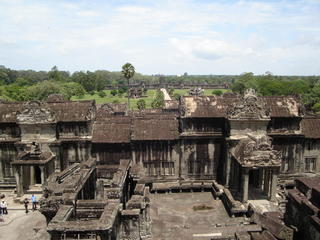The impressiveness of Angkor Wat is undeniable as soon as you climb off of the motorbike and
the start of the first causeway. The 5 massive corn-cob shaped towers at the center are more than 2 km away and you are fist faced by a 400 meter long, 45 m wide causeway across a moat. At the far end of the causeway is a massive gopura, or entry gate. This gate is part of the 4th enclosing wall which is 1500 m on each side. (Enclosing walls are numbered from the center out.) Passing through the gate the ceiling soars above you to a height of more than 15 meters. Archaeology geeks notice that the Khmer people had not figured out the arch yet, so the width of the entry way is wide enough for your average sized car, but not much more. It is scary to think about how big of things they would have built if they had known about arches.

Darkness gives way to light as you exit the gatehouse and you are again faced with another raised causeway stretching from the fourth to the third enclosing wall. A large library and a reflecting pool are on each side of the causeway as you continue your trek.

The main towers of Angkor continue to grow taller with each step that you take down the causeway. The heavily worn stones are made of sandstone and measure approximately 1.2 m by 0.7 m. Along the edge of each causeway a seven headed naga forms the railing. Tourists, unfortunately, are everywhere. At the eastern end of the causeway you climb up 2 meters worth of stairs and cross the Terrace of Honor and reach the third enclosing wall.
The third enclosing wall is one of the most decorated parts of the entire Angkor complex. Along each side of the 3rd wall there are two massive panels, each depicting various scenes from Hindu Mythology. Each panel is about 2 meters tall and stretches for around 100 m. All of the carving is done with bas relief technique and clearly required and incredible time and energy expenditure. The detail is incredible to say the least.
each side of the 3rd wall there are two massive panels, each depicting various scenes from Hindu Mythology. Each panel is about 2 meters tall and stretches for around 100 m. All of the carving is done with bas relief technique and clearly required and incredible time and energy expenditure. The detail is incredible to say the least.

 After circling the outside of the third wall you continue inward and up through more, less decorated galleries, until you reach the courtyard between the second and the 1st enclosing walls. From here you are faced with a set of steps that rise about 15 meters and a 70 degree angle from horizontal. Each step has been worn VERY smooth and is no more than 6-8 inches wide. Going up isn't too bad, but coming down is really nerve racking because there is usually an older japanese tourists a little ways above you and you just know that if they slip and fall you are going to get really hurt, probably break something, and the rest of your vacation will be shot.
After circling the outside of the third wall you continue inward and up through more, less decorated galleries, until you reach the courtyard between the second and the 1st enclosing walls. From here you are faced with a set of steps that rise about 15 meters and a 70 degree angle from horizontal. Each step has been worn VERY smooth and is no more than 6-8 inches wide. Going up isn't too bad, but coming down is really nerve racking because there is usually an older japanese tourists a little ways above you and you just know that if they slip and fall you are going to get really hurt, probably break something, and the rest of your vacation will be shot.
The view from the top is wonderful and it is sort of incredible to realize how far you walked and how high up you have climbed.

I am sorry that I have not posted more yet, but the place in Siem Reap with the fastest internet connection does not have computers with CD drives and the internet cafe's that do have CD drives have the slowest connections... Joseph Heller would love it.


No comments:
Post a Comment